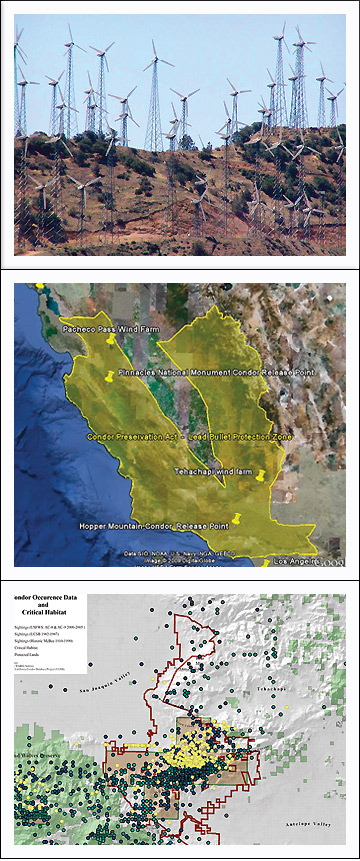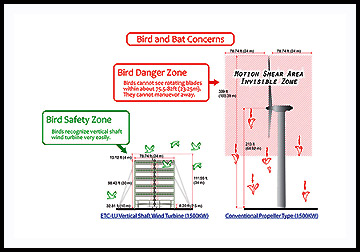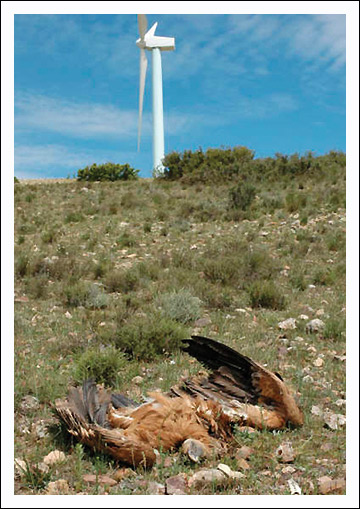Wind turbines are killing condors
BY JIM WIEGAND: Special to Western Outdoor News: Oct 07, 2009 wonews.com
BY JIM WIEGAND: Special to Western Outdoor News: Oct 07, 2009 wonews.com
Two of California’s highest priority environmental causes – promoting renewable energy and saving the California condor – are on a collision course. The proliferation of prop wind turbines and their well-documented history of killing birds of prey have put the future of the California condor at great risk.
The fact is, in recent years, many missing condors have most likely perished at wind farms in California. Many of the captive bed condors, released into the wild since 1992, have turned up missing. Nearly 1⁄3 (one-third) of all the captive bred condors released, perish for unknown reasons. If one looks into the scientific literature, collision is nearly always listed as a major cause of death to condors. But there is never any mention of collision in association with the thousands of prop wind turbines with blade tips spinning at 200 miles per hour in their habitat.
The number one cause of golden eagle mortality in California is from collisions with prop wind turbines. Why not the California condor?
At Altamont Pass, where nearly 7,000 prop wind turbines choke the landscape, over 1,000 birds of prey die each year. One of the most commonly killed species at the Altamont pass wind farm is the turkey vulture. This is well documented.
The condor, like the turkey vulture, is a scavenger. With their huge wings, condors catch thermal air currents and glide for hours looking for food. Flights for food can take a condor as far as 150 miles. A trip to a wind farm would be an easy flight if there were one located nearby. Pacheco Pass and the Tehachapi Pass wind farms currently exist in Condor habitat and support populations of game animals.
In Spain, the Griffon vulture, which is much like the condor in size and habits, is a very large vulture that is somewhat slow and awkward in flight. There, the prop turbine wind farms have been a slaughterhouse. Between 2000 and 2006, almost 1,000 Griffon vultures were found dead at just five of Spain’s wind farms in the Zaragoza province. Mark Duchamp (save the eagles) estimates that nearly 2,000 Griffon vultures die at the prop wind farms each year in Spain.

TOP: Huge wind turbine farms in the middle of condor country kill thousands of birds every year, and it is assumed that condors are part of the numbers. In addition, other birds killed in the turbines would attract condors, making them even more dangerous. MIDDLE: Condors are at far more risk of being killed in wind turbines within their range than by the very unlikely event of eating a wounded animal and ingesting enough lead to impact their health. BOTTOM: This chart shows condor occurrences, and how likely it is that they would have contact with wind turbines within their critical range.
In the summer of 2006 the following statement was made in a press release: “The government began releasing condors in 1992, and there are now about 130 condors in the wild, 68 of them in California. Of 127 condors released in California from 1992 through 2006, 46 birds (36 percent) died or disappeared and are presumed dead. Scientists say poisoning from scavenging carcasses tainted by lead ammunition is likely responsible for many of the deaths.” These figures were published three years ago when wildlife advocates filed suit to replace toxic lead bullets with safer alternatives.
Now, three years later, the number of missing and presumed dead condors is even higher. Yet nothing was said about the possibility of the missing condors perishing at two of California’s largest prop turbine wind farms, Pacheco Pass and Tehachapi Pass. Both are located within the condors’ home range and both have been in operation for decades.
In response to increasing losses to the reintroduced population and a growing number of unknown deaths and disappearances, Ventana Wilderness Society initiated an intensive (weekly) aerial GPS tracking program for all condors in California beginning in fall of 2000 to augment the ongoing ground tracking effort. Some of the satellite tracking is shown in the image provided. The image shows a history of condor sightings in the habitat occupied by the Tehachapi Pass Wind farm. THIS GRAPH shows how vertical shaft wind turbines are recognized by birds and avoided, while rotating wind turbines are undetectable to them

This graph shows how vertical shaft wind turbines are recognized by birds and avoided, while rotating wind turbines are undetectable to them, causing a major threat to bird survival.
An August, 2008, 59-page report, “Status of the California Condor and Efforts to Achieve its Recovery,” concluded that California condors, rescued from extinction in an elaborate and expensive recovery effort, have become tantamount to a zoo animal in the wild and can’t survive on their own without a ban on lead ammunition across its vast western ranges, the scientific study has concluded. The majestic scavengers, bred in captivity and released to nature in recent decades, require “constant and costly human assistance.” The report prepared by the AOU Committee on Conservation, California Condor Blue Ribbon Panel, A Joint Initiative of The American Ornithologists’ Union and Audubon California.
Not one word was written about the possibility of Prop Wind Turbines killing condors. Why not? These are all bright people. They all know the extreme danger of prop turbines to birds of prey. With a Prop Turbine, one fly-over could mean death. A single carcass seen from miles away could draw in a condor on any given day. In sharp contrast, the National Audubon Society hosted a news conference in September 1999 to denounce Enron Wind Corp.’s (now owned by GE) plans to build a prop wind farm near the town of Gorman in Southern California. “It is hard to imagine a worse idea than putting a condor Cuisinart next door to critical condor habitat,” said Audubon Vice Pres. Daniel Beard.
Tehachapi Pass wind farm (now owned by GE) sits right next to critical condor habitat. There are 5,000 prop wind turbines spinning at this location. There are contracts with Southern California Edison to expand the Tehachapi Pass wind farm to more than 50 square miles of wind turbines, which is triple the size of any existing U.S. wind farm. As a result, more Condors will be killed. GRIFFON VULTURES, such as this one, are killed by the thousands in wind turbine farms in Spain, and there is no reason to suspect that the same is not occurring in California.

Griffon vultures, such as this one, are killed by the thousands in wind turbine farms in Spain, and there is no reason to suspect that the same is not occurring in California.
Recently a ban was placed on the use of lead bullets in the habitat of the condor. In December, 2007, the California Department of Fish and Game prohibited the use of projectiles containing lead for hunting deer, bear, wild pig, elk, and antelope in areas designated as California condor range. This was for good reason, because the condors were eating carcasses left in their field by hunters and ingesting lead bullet fragments. Wounded animals that escaped would go off and die, only to be eaten later by condors. Scientists found very high levels of lead in some of the sick and condors. Similarly in Spain, dangerously high levels of lead were also found in the Griffon Vulture.
Assembly bill 821, the Ridley-Tree Condor Preservation Act, Now makes it a crime to use lead bullets in thousands of square miles of Condor in the Southern California habitat that surrounds the Sacramento Valley floor. A look at the map provided shows the area protected by law highlighted in yellow. The map also clearly shows that two of California’s largest Prop Turbine farms, Pacheco Pass and the Tehachapi Pass wind farms, are located well within the protected condor habitat. Lead bullets are a great danger to Condors, but so are prop turbines. How is the Condor going to be protected from the proliferation of prop turbines from the wind industry? This is clearly the biggest danger facing the Condor.
But, according to Chris Parish, condor program director for the Peregrine Fund, “Aside from lead poisoning, there is little to stop condors from spreading clear up to British Columbia.” Sorry, Mr Parish, you are wrong. Prop turbines will stop the condor as sure as the Great Wall of China stopped invaders from the north.
As it now stands, without captive breeding and feeding stations, the California condor will never be able to expand its range where there is a prop turbine farm located near its critical habitat. The reproductive rate is too low and it is just too easy for them to cruise a few miles into the spinning blades of a wind farm. In fact, if it were not for the feeding stations, many more condors would have wandered off into the Pacheco Pass and Tehachapi Pass wind farms looking for food, only to perish.
I am an expert on birds of prey and in my opinion, California condors have died at the Tehachapi Pass wind farm. An independent team of observers having full access to the Tehachapi Pass wind farm could confirm this in 12 to 24 months time. No one from the blue ribbon panels associated with the 2008 Condor report should be a part of the independent team.
This may be the best reason yet to move on from the prop wind turbine era and stop the slaughter of birds of prey. The more efficient, vertical shaft wind turbines and other designs currently in development will take care of this problem.
We at Western Outdoor News do not believe that lead bullet fragments in “wounded animals” are a “great threat” to condors. Hunters are far too meticulous in tracking and retrieving any animals that may be wounded. But we do firmly believe that wind turbines are very probably a greater threat to condors.
URL to article: https://www.wind-watch.org/news/2009/10/07/wind-turbines-are-killing-condors/